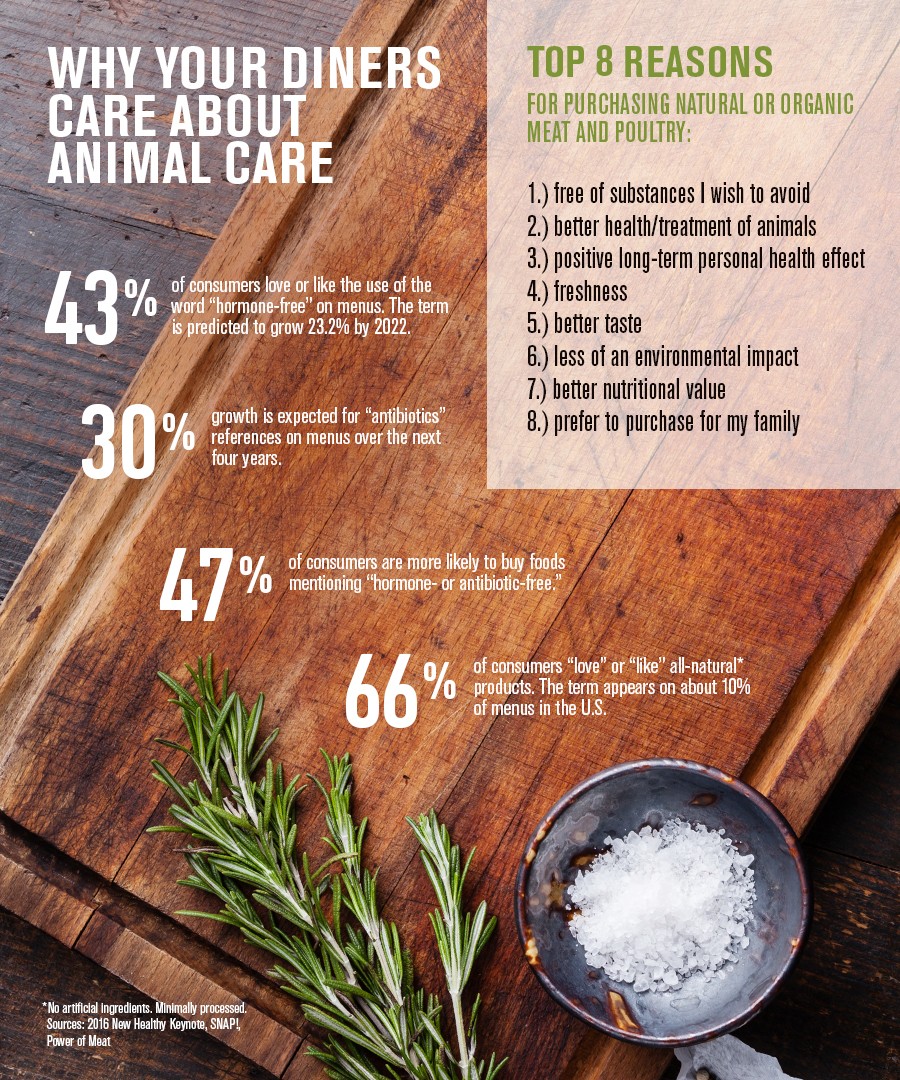WHY ANIMAL CARE MATTERS TO DINERS
And why it should matter to you
As conversations around food transparency continue to grow, restaurateurs are now putting more thought into what they’re serving and, more importantly, how the food is getting to the menu. According to the Hartman Group, animal welfare has become a clear case of “better for me, better for the world” for most consumers who are sustainability-minded.
With 76% of consumers considering sustainable practices to be important, foodservice professionals must join diners in the fight for creating real, lasting change within the industry. In a recent survey by Technomic, 73% of operators see a greater role for sustainability over the next two years. Because of this, operators should continue asking questions about how their food is raised, and leverage the use of third-party certifications to increase transparency for their diners. Some of the most recognized certifiers include USDA Organic, Fair Trade Certified™, Non-GMO Project Verified, American Grassfed Association, Certified Humane and Animal Welfare Approved (Hartman Group Sustainability, 2017).
When it comes to animal welfare, today’s diners are looking for more food choices, more accountability and full transparency from the people who bring food to their plates. Many consumers are concerned about the treatment and care of agricultural animals – including how they’re raised and what they’re fed. Among operators, 48% consider humane treatment of animals to be very important when making purchasing decisions, and that number is expected to increase (Technomic 2018). Beyond their environmental concerns, many diners are pushing for better animal care practices for their own personal benefit. Recent studies show some of the top reasons why consumers like organic meat and poultry is that the products provide better quality, nutritional value, positive long-term health effects, and are free of harmful substances (The Power of Meat, 2017).
HOW TO BRING ANIMAL CARE TO THE FOREFRONT OF YOUR MENU
Choose the right labels
Food labels help improve transparency for your diners, but they can also help operators boost profits. Menus with dishes that include animal care claims can expect a median-price-per-dish increase over those that don’t (Datassential 2019, Summer Scoop). Additionally, it’s important to treat your menu as a contract between you and your diners. When you make a claim or apply a label, it should be 100% accurate.
- Certified Humane®: “Meat, dairy and eggs with Humane Farm’s Certified Humane classification come from farm animals raised with shelter, resting areas and space sufficient to support natural behavior,” says Mimi Stein, executive director of Humane Farm Animal Care. Restaurants that sign up for the organization’s “traceability audits” are given a certification sticker indicating that their products have been tracked back to a farm, barn, flock or herd that was inspected by its auditors.
- Humanely Raised: When selecting specific food labels, it’s important to have a clear understanding of what they actually mean. “The terms ‘humanely raised’ and ‘raised with care’ are not clearly defined by the USDA, and are not backed by any audits or specific standards,” says Daisy Freund, Director of Farm Animal Welfare at the American Society for the Prevention of Cruelty to Animals. Unless the USDA allows for the use of a certain term, it’s better to use third-party certifications to ensure your food is living up to the labels.
- Raised Without Antibiotics: Choosing animal products that are raised without antibiotics helps to address the public health challenge of antibiotic resistance (Consumer Reports). For meat and poultry products, this phrase indicates that animals were not given any antibiotics through feed, drinking water or injections. The U.S. Centers for Disease Control and Prevention (CDC) estimates that antibiotic-resistant bacteria causes more than 2 million infections annually.
- American Humane Certified™: This label indicates that animals were raised on farms that meet the standards of the American Humane Association. The American Humane Certified label is based on the “Five Freedoms of Animal Welfare,” which include freedom from 1) hunger and thirst, 2) discomfort, 3) pain, 4) fear and distress, and 5) freedom to express normal behavior (Consumer Reports). These standards are imposed to ensure that animals are well-cared-for and able to live in abuse-free environments.
Understand the Environmental Impact
The more knowledge and awareness that operators have about how animals are raised, the more quickly they can begin to implement long-lasting changes in the industry. In 2017, the United States Environmental Protection Agency (EPA) reported that, of the total U.S. greenhouse gas emissions, 9% came from agricultural activities. Livestock, such as cattle, produce methane (CH4) as part of their natural digestion process, which accounts for almost a third of those emissions. Additionally, manure management accounts for roughly 14% of total greenhouse gas emissions for the agricultural sector (EPA 2017). Farmers can reduce methane emissions by adjusting feeding practices and improving overall pasture quality. As conversations around the environment continue to increase, it’s important to understand how certain menu selections can make a global impact. Because more than 88% of consumers think it’s important to protect the environment from harmful chemicals (National Research Center 2015), operators should care, too. This starts with asking questions about food sources, agricultural practices and animal care.
Visit the Hungry for Better Resource Library for more articles full of valuable insights and tips on food sourcing, sustainability, food waste, and more.


